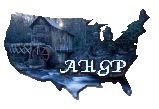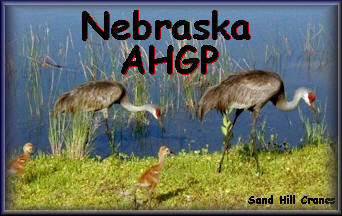Nebraska Livestock Brand Inspection
The system of brand inspection in operation at the large market
centers, where branded stock from the western ranges are shipped
for sale and distribution, is the outgrowth of organization
among the range cattle owners. The branding of cattle and horses
became a necessity years ago, when the ranges began to fill up
and the herds commenced to encroach upon each other's grazing
territory. The mixing of unbranded stock demanded more than
individual recognition; a mark placed upon the animal by a
burning brand was by common consent brought into general use.
Not only was it found convenient to satisfy disputes of
ownership of animals between neighboring ranchmen, but it served
the purpose of detection often when the branded animals were
stolen and driven off their owner's range.
The duplicating of brands became a matter of much concern among
ranchmen as the herds began to multiply and the range country
fill up with stock. To obviate this difficulty a system of
recording brands was introduced, some states adopting a county
register, while others had brand laws enacted providing for the
registering of all brands at the state capital.
Nebraska at first used the county register system of filing
claims for brands with the County Clerk, but later had a State
brand law passed, which is now in successful operation. All
brands are now filed with the Secretary of State, and no two
persons can secure the registering of the same brand, and no
brand is a legal brand unless registered.
There is no State provision or law for brand inspection in
Nebraska, this being provided for entirely through the two range
stock associations in the State, the Nebraska Live Stock
Growers' Association, with headquarters at Alliance, and the
Keya Paha Cattle Growers' Association, at Ainsworth. These two
Associations employ their brand inspection through the Wyoming
Live Stock Association, which keeps an inspector at South Omaha,
Chicago, Sioux City, St. Joseph and Kansas City, and handles the
inspection for South Dakota, the Nebraska Associations and the
State of Wyoming. Only members of these Associations who pay
into their Association fund their annual assessments are able to
receive benefits from the inspection. The inspectors receive
from the Secretaries of the various Associations, or states
making appropriations for such inspection, a list of the brands
of the persons entitled to its benefits. This brand book
contains the name and address of each person entitled to
protection and an exact copy of each brand.
A person to fill the position of brand inspector must of
necessity be an expert in deciphering brands at sight. The work
of the brand inspector is done on horseback, and before the
yarded cattle commence to sell and move to the scales. If strays
are found they are separated from the bunch, sold separate, and
the commission firm whose consignment they were in, charges up a
proportionate amount of freight, yardage, commission, etc.,
against the animals and holds the proceeds subject to release by
the inspector, to go into the hands of the owner of the cattle,
or to the Secretary of the Association furnishing the brand.
All cattle carrying uncertain brands, or where there is a doubt
as to a brand being on, in the care of the inspector, the animal
is roped, quickly made secure, and a pair of clippers applied
over the brand, and the surface of the skin exposed to view. It
is believed that very few stray cattle escape detection from the
critical eye of the inspector. It is reasonably certain that
this system of checking, with the detective methods adopted by
the Stock Growers' Associations in the range districts, has
practically put a stop to cattle and horse rustling. It is
almost an impossibility for a shipment of stolen cattle to get
through the yards at any of the points where the brand
inspection is employed, without detection. The work of the brand
inspection department at South Omaha is presented as follows.
For the period April 1, 1902, to April 1, 1903, number of strays
arrested and proceeds of sales returned direct to owners of
stock by the commission firms:
Wyoming 2,856 $ 96,532.80
South Dakota 1,963 70,275.40
Nebraska 1,239 36,696.46
Total 6,058 $203,504.66
Number arrested and proceeds returned to owners through
Secretaries of the Stock Growers' Associations:
Number. Value.
Wyoming- 1.151 $ 38,922.81
Nebraska 145 4,344.35
South Dakota 1,086 , 38,879.17
Total 2,382 $ 82,146.33
Making a grand total for the year, for these three states, 7,440
head, and a net sale to owners of $285,650.58.
Wyoming was the first State to commence brand
inspection. This was introduced at the South Omaha Stock Yards
by the Wyoming Association, April 1, 1892, and down to the
present year, April 1, 1903, has had 61,784 head of stock caught
up by the South Omaha brand inspectors, yielding a net return to
the owners of $1,798,343.28.
South Dakota adopted the brand inspection in
1893, and through the Wyoming inspection at South Omaha has had
down to April 1, 1903, 16,941 head of stock arrested, producing
a net return to the owners of $615,878.91.
Nebraska did not arrange for brand inspection
until 1899, and through the same agency at South Omaha had, from
that year down to April 1, 1903, 3,119 cattle arrested, yielding
a net return to the owners of $102,348.06.
The entire brand inspection at South Omaha, with the States
named, commencing at 1892, shows a total of 80,844 head of
strays arrested, yielding to their owners, after all expenses of
freight, commission, etc., have been deducted, $2,516,569.84.
Notwithstanding that Nebraska has more than double the cattle
population of South Dakota, there was arrested at South Omaha
the past year 700 more strays for South Dakota than Nebraska.
Nebraska's cattle population is almost five times that of
Wyoming, yet there were two and a half times more strays
arrested the past year at South Omaha for Wyoming, a fact which
is explained by the additional security that the fenced range of
Nebraska offers to the livestock business over the more open
districts.
The Western Nebraska cattle raiser is comparatively free from
loss by strays and stolen cattle. The opportunities to engage in
the business are numerous, and the advantages offered have no
equal in any other section of range country.
Nebraska AHGP

A Condensed History of Nebraska for fifty years to date,
Compiled by Geo. W. Hervey, Editor, and Published by Nebraska
Farmer Co., Omaha, Nebraska, 1903.
Nebraska Links

Hosted Free |
 |
Please stop by again!!
This page was last updated
Copyright August © 2011 -
AHGP The American History and Genealogy Project.
Enjoy the work of our webmasters, provide a link, do not copy their work.
|
![]()

![]()